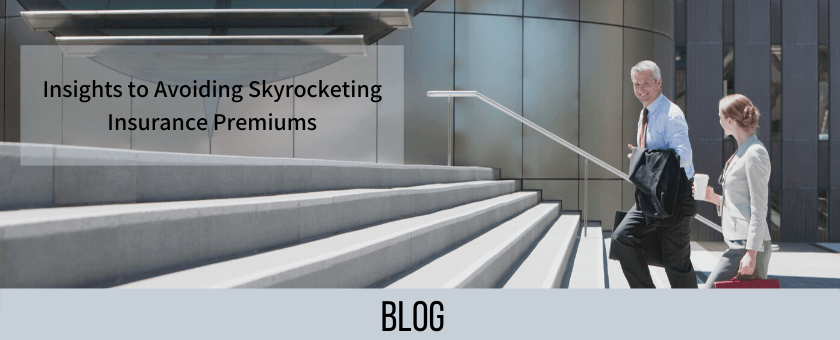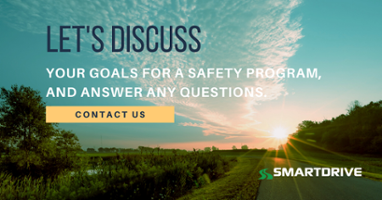
Insights on Avoiding Skyrocketing Insurance Premiums Part 3
Featuring Matthew Rathje, Vice President of Risk Solutions, TrueNorth Companies
In our recent webinar, 10 Actions You Can Take Today to Avoid Skyrocketing Insurance Premiums, four industry professionals provided their insights to help fleets avoid increasing premiums today … and in the future.
 SmartDrive spent some time with Matthew Rathje, Vice President of Risk Solutions, TrueNorth Companies, and delved further into his recommendations. Matt has over 12 years of claims and risk solutions leadership experience working with clients, insurance carriers and strategic partners. He currently leads TrueNorth’s Risk Solutions Team, which is focused on driving value to clients in Claims, Safety & Loss Control, Strategic Communications and Technology.
SmartDrive spent some time with Matthew Rathje, Vice President of Risk Solutions, TrueNorth Companies, and delved further into his recommendations. Matt has over 12 years of claims and risk solutions leadership experience working with clients, insurance carriers and strategic partners. He currently leads TrueNorth’s Risk Solutions Team, which is focused on driving value to clients in Claims, Safety & Loss Control, Strategic Communications and Technology.
SmartDrive: You talk about how important innovation is to managing a fleet’s insurance premiums. Do you have suggestions as to how fleets can innovate?
Matt: In-cab technologies are advantageous to help in both a preventive and post-accident state to be sure you understand the facts and circumstances from the onset of a claim. This will likely result in faster claims resolutions, rather than dragging out for several months or several years. In-cab technology will also help compress legal expense dollars that you may have spent on those claims without it. Remember, however, innovation doesn’t always mean new technology; it could also be focusing in areas that are often under-served, like subrogation
Another area that is having a dramatic impact on motor carriers in the workers compensation space is Electrodiagnostic Functional Assessment . EFA provides a diagnostic view of an employee post-offer, pre-employment. EFA is helpful in the event an individual should allege a work injury. When it occurs, you can pull the pre-employment EFA results and do another test for comparison. This provides a solid baseline as to that individual’s body makeup before and after the injury. Is there truly a work-related injury? Or, did the injury occur prior to employment? Many large motor carriers have experienced hundreds of thousands, to tens millions of dollars in savings using this technology.
Employees appreciate it because they can receive faster and more pinpointed treatment for work-related injuries. Fleets appreciate it because it provides better treatment for the injured worker. With workers comp, unfortunately from time to time, there’s a vicious cycle of injury, therapy, back to work, more therapy, MRI, work, therapy, etc. From a timeliness of treatment and cost of the claim, you’re able to compress claims costs because you can get someone to treatment and return to work quicker. If the injury doesn’t appear to be work related, the employer will be able to capture workers’ compensation savings and direct to the appropriate medical payor. It’s about ensuring the employee is getting the appropriate care and whether the injury is truly work related or not.
SmartDrive: In the webinar, you talked about subrogation. You mention using it to your advantage. Can you share your thoughts about this?
Matt: The frequency and severity of claims have increased due to inflation, medical costs, litigation costs, injuries, etc. Unfortunately, most motor carriers have claims administrators who are juggling many different responsibilities and have limited capacity to focus on subrogation. However, looking at industry benchmarks from the National Association of Subrogation Professionals, 25-28% of tractor trailer physical damage and cargo claims are recoverable.
carriers have claims administrators who are juggling many different responsibilities and have limited capacity to focus on subrogation. However, looking at industry benchmarks from the National Association of Subrogation Professionals, 25-28% of tractor trailer physical damage and cargo claims are recoverable.
Recovery Concepts & Solutions is a company that focuses on the trucking space – they have helped many companies improve their bottom line and loss ratio. There are few trucking companies that have subrogation experience, let alone experience across all 50 states; each state has different case law and statutes. That’s why it’s critical to bring in someone who understands the industry and specializes in subrogation. If you can bring back dead dollars from old claims, you can infuse your bottom line.
The key to subrogation is to discover, plan, implement and manage.
- Understand your current subrogation ratio – dollars recovered divided by dollars paid
- Initially focus on tractor/trailer physical damage.
- Look at your loss run on all of your claims including cargo and workers’ compensation
- Understand the state of your liabilities.
- Look into your claims file and determine what support documents you have.
Someone who specializes in subrogation can help you substantiate your loss of use or loss of revenue and help you determine the actual impact to your overall business. Be sure you get everything you’re entitled to.
Remember that the life cycle on claims is 75 to 90 days once you begin engaging in the process. You can typically expect dollars to begin coming in within 30 days, with most dollars recovered within 90 days. Unless there’s an unusual circumstance that would lead to litigation, many of these dollars are recovered without getting an attorney involved.
SmartDrive: You mention bolstering your investigation on the front end to increase your likelihood of subrogation activity on the back end. Can you provide some insight?
Matt: When it comes to subrogation, In-cab video technology is an arrow in your quiver. It helps you have an easier conversation with the adverse party when pursuing subrogation since video provides the facts.
What’s most important is to conduct an immediate initial accident investigation and have the appropriate party cited. Whether your driver is at fault or not, it’s likely your driver will be emotional; get an attorney on site to work with the driver. This will help ensure that there isn’t an overstatement, or misstatement, of the facts and circumstances. Make sure the claim is reported immediately to your insurance company. Collect and preserve all evidence. And, before releasing equipment back to your driver or salvaging it, ensure the other party has the right to an investigation and has been given the option to look at it. Don’t dispose of any information that can be used for future claim filing.
It’s important to be mindful of how you talk to the media. Don’t attempt to find or assign any blame at the time of the accident and be sure everyone is protected and empathetic toward the other party. Get guidance from your attorney and insurance company before interacting or taking action with the adverse party as this could have longstanding impact on the outcome of the claim.
Remember that preservation of evidence is crucial. You and your attorney will want to review the video and better understand who was at fault. Get out in front with public relations and those looking to seek insight regarding your safety practices. Real people, real lives are impacted by the accident, whether at fault or not.
SmartDrive: You discussed an advocacy-based claims handling approach for workers comp claims. Can you help people understand what you mean and how to better approach these claims? Perhaps what NOT to do?
Matt: Workers comp claims have all, too often, been adversarial, leading to unnecessary litigation and increased costs. But the industry has shifted its mindset toward taking care of its employees, rather than ignoring them. For instance, one company I know provides handwritten notes to injured workers on a regular basis just letting them know that “we’re here to take care of you,” encouraging them to get back to work.
 Start with finding different options to treat your injured employee. Make sure they get the best, appropriate care for their work-related injury. Know who is communicating with your employee. Oftentimes, it’s the HR or claims manager who may never have interacted with the injured employee before the incident. Fortunately, it’s likely the employee’s driver manager or another manager may have a really good relationship with them. Leverage those relationships. Constant communication is critical.
Start with finding different options to treat your injured employee. Make sure they get the best, appropriate care for their work-related injury. Know who is communicating with your employee. Oftentimes, it’s the HR or claims manager who may never have interacted with the injured employee before the incident. Fortunately, it’s likely the employee’s driver manager or another manager may have a really good relationship with them. Leverage those relationships. Constant communication is critical.
All too often, people think that injuries are fraudulent when, most of the time, they are truly work-related injuries. The skills of showing empathy, listening to your worker and relying on your communication skills are extremely important to bringing back a healthy, happy employee quicker, which will reduce your workers’ compensation costs.
Another area for consideration is telemedicine. During the COVID-19 crisis, many facilities serving injured workers, including physical therapy centers and occupational health clinics, are limiting access or shutting their doors. As a result, injured workers, and others, are using telemedicine to avoid encountering COVID-19-infected patients in doctors’ offices. The COVID-19 outbreak has increased the awareness and adoption of telemedicine and this will likely be the norm for a broader audience on a go-forward basis. It’s a great opportunity for truck drivers and the mobile workforce to get care quicker and more efficiently.
SmartDrive: You ended by stating that claims are often a reactionary environment. How should a fleet look at claims and how should they change their mindset when they get a claim?
Matt: From the moment a claim hits your desk – whether you’re an employer, an insurance company or an adjuster – the speed to which that claim is handled and the responsiveness and attentiveness you have to a work-related injury is key. Your responsiveness and any proactive measures you’ve taken, such as in-cab video, will enable you to get out in front of those situations quickly and understand where you sit with that claim. If you communicate early and often with all parties involved, you are highly likely to have a better outcome than you would otherwise.
SmartDrive: Finally, what’s one piece of advice you’d give a fleet today to avoid skyrocketing insurance premiums?
Matt: I recommend focusing on proactive efforts around handling claims and looking at newer, innovative solutions around claims handling, such as EFA technology and in-cab video, which result in a dramatic impact to your loss ratio. If the investment is palatable to you as an organization, the overall long-term impact is going to be dramatic. Also, having a good subrogation program going forward will compress the loss ratio. You’ll have an initial infusion of dollars from the closed file review while making sure you’re recovering as much as possible on a go-forward basis.
To learn how to settle claims quickly and take control of your insurance costs, contact SmartDrive today.
- Posted by Melissa.Senoff@smartdrive.net
- On 29 June 2020
